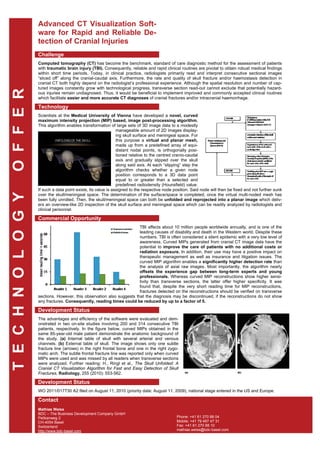
Advanced CT Visualization Software
- 1. Advanced CT Visualization Soft- ware for Rapid and Reliable De- tection of Cranial Injuries Challenge Computed tomography (CT) has become the benchmark, standard of care diagnostic method for the assessment of patients with traumatic brain injury (TBI). Consequently, reliable and rapid clinical routines are pivotal to obtain robust medical findings within short time periods. Today, in clinical practice, radiologists primarily read and interpret consecutive sectional images “sliced off” along the cranial-caudal axis. Furthermore, the rate and quality of skull fracture and/or haemostasis detection in cranial CT both highly depend on the radiologist’s professional experience. Although the spatial resolution and number of cap- tured images constantly grow with technological progress, transverse section read-out cannot exclude that potentially hazard- O F F E R ous injuries remain undiagnosed. Thus, it would be beneficial to implement improved and commonly accepted clinical routines which facilitate easier and more accurate CT diagnoses of cranial fractures and/or intracranial haemorrhage. Technology Scientists at the Medical University of Vienna have developed a novel, curved maximum intensity projection (MIP) based, image post-processing algorithm. This algorithm enables transformation of large sets of 3D image data to a modestly manageable amount of 2D images display- ing skull surface and meningeal space. For this purpose a virtual and planar mesh, made up from a predefined array of equi- distant nodal points, is orthogonally posi- tioned relative to the centred cranio-caudal axis and gradually slipped over the skull along said axis. At each “slipping” step the algorithm checks whether a given node position corresponds to a 3D data point equal to or greater than a selected and predefined radiodensity (Hounsfield) value. If such a data point exists, its value is assigned to the respective node position. Said node will then be fixed and not further sunk T E C H N O L O G Y over the skull/meningeal space. The determination of the surface/space is completed, once the virtual multi-noded mesh has been fully unrolled. Then, the skull/meningeal space can both be unfolded and reprojected into a planar image which deliv- ers an overview-like 2D inspection of the skull surface and meningeal space which can be readily analyzed by radiologists and clinical personnel. Commercial Opportunity TBI affects about 10 million people worldwide annually, and is one of the leading causes of disability and death in the Western world. Despite these numbers, TBI is often considered a silent epidemic with a very low level of awareness. Curved MIPs generated from cranial CT image data have the potential to improve the care of patients with no additional costs or radiation exposure. In addition, their use may have a positive impact on therapeutic management as well as insurance and litigation issues. The curved MIP algorithm enables a significantly higher detection rate than the analysis of axial raw images. Most importantly, the algorithm nearly offsets the experience gap between long-term experts and young professionals. Whereas curved MIP reconstructions show higher sensi- tivity than transverse sections, the latter offer higher specificity. It was found that, despite the very short reading time for MIP reconstructions, fractures detected on the reconstructions should be verified on transverse sections. However, this observation also suggests that the diagnosis may be discontinued, if the reconstructions do not show any fractures. Consequently, reading times could be reduced by up to a factor of 5. Development Status The advantages and efficiency of the software were evaluated and dem- onstrated in two on-site studies involving 200 and 314 consecutive TBI patients, respectively. In the figure below, curved MIPs obtained in the same 85-year-old male patient demonstrate the anatomic background of the study. (a) Internal table of skull with several arterial and venous channels. (b) External table of skull. The image shows only one subtle fracture line (arrows) in the right frontal bone and one in the right zygo- matic arch. The subtle frontal fracture line was reported only when curved MIPs were used and was missed by all readers when transverse sections were analyzed. Further reading: H., Ringl et al., The Skull Unfolded: A Cranial CT Visualization Algorithm for Fast and Easy Detection of Skull Fractures, Radiology, 255 (2010): 553-562. Development Status WO 2011/017730 A2 filed on August 11, 2010 (priority date: August 11, 2009), national stage entered in the US and Europe. Contact Mathias Weiss BDC – The Business Development Company GmbH Pelikanweg 2 Phone: +41 61 270 88 04 CH-4054 Basel Mobile: +41 79 487 47 31 Switzerland Fax: +41 61 270 88 10 http://www.bdc-basel.com mathias.weiss@bdc-basel.com